
Often described as the last year of the "Golden Era" before World War II and other realities intervened, 1941 was a thrilling year as America watched two major events unfold: Ted Williams of the Red Sox hunting for the elusive .400 batting average and Joe DiMaggio getting hits in consecutive ballgames. By the end of his hitting streak, DiMaggio hit in 56 consecutive games, the current major league record and one often deemed unbreakable.[17]
Two months and one day after the Yankees beat the Brooklyn Dodgers in the 1941 World Series, the Japanese attacked Pearl Harbor, and many of their best players, including DiMaggio himself, went off to serve in the military. The Yankees still managed to pull out a win against the St. Louis Cardinals in the 1943 World Series.
In 1945 construction magnate Del Webb and partners Dan Topping and Larry MacPhail purchased the team from the Ruppert estate for $2.8 million; MacPhail was bought out in 1947.
After a few slumping seasons, McCarthy was fired early in 1946. A few interim managers later, Bucky Harris took the job, righting the ship and taking the Yankees to a hard fought series victory against theDodgers.
Despite finishing only three games behind the first place Cleveland Indians in 1948, Harris was released in favor of Casey Stengel, who had a reputation of being a clown and managing bad teams. His tenure as Yankee field manager, however, was marked with success. The "underdog" Yankees came from behind to catch and surprise a powerful Red Sox team on the last two days of the 1949 season, a face off that fueled the beginning of the modern Yankees–Red Sox rivalry. By this time, however, DiMaggio's career was winding down, and the "Yankee Clipper" retired after the 1951 season. This year marked the arrival of the "Oklahoma Kid", Mickey Mantle, who was one of several new stars that would fill the gap.
Stengel's squad in the 1950s (1951–1959)
Bettering the clubs managed by Joe McCarthy, the Yankees won the World Series five consecutive times from 1949–1953 under Stengel, which continues to be the major league record. Led by players like center fielder Mickey Mantle, pitcherWhitey Ford, and catcher Yogi Berra, Stengel's teams won ten pennants and seven World Series titles in his twelve seasons as the Yankees manager. Stengel was a master at publicity for the team and for himself, even landing a cover story inTime magazine in 1955. The 1950 was the only one of those five championships not to be won against either the New York Giants or Brooklyn Dodgers; it was won against the Whiz Kids of the Philadelphia Phillies.
In 1954, the Yankees won over 100 games, but the Indians took the pennant with an AL record 111 wins. In 1955, the Dodgers finally beat the Yankees in the World Series, after five previous Series losses to them, but the Yankees came back strong the next year. On October 8, 1956, in Game Five of the 1956 World Series against the Dodgers, pitcher Don Larsen threw the only perfect game in World Series history,[18] which remains the only perfect game in postseason play and was the only no-hitter of any kind to be pitched in postseason play until Roy Halladay pitched a no-hitter on October 6, 2010.[19]
The Yankees lost the 1957 World Series to the Milwaukee Braves. Following the Series, the New York Giants and the Brooklyn Dodgers both left for California, the former leaving for San Francisco and the latter moving to Los Angeles, leaving the Yankees as New York's only baseball team. In the 1958 World Series, the Yankees got their revenge against the Braves, and became the second team to win the Series after being down three games to one. For the decade, the Yankees won six World Series championships ('50, 51, '52, '53, '56, '58) and eight American League pennants (those six plus '55 and '57). Led by Mantle, Ford, Berra, Elston Howard (the Yankees' first African-American player), and the newly acquired Roger Maris, the Yankees entered the 1960s seeking to replicate their success of the 1950s.
The M&M Boys: Mantle and Maris (1960–1964)
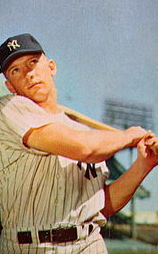
Mickey Mantle was one of the franchise's most celebrated hitters, highlighted by his home run chase with Roger Maris in 1961
Arnold Johnson, owner of the Kansas City Athletics, was a longtime business associate of then-Yankees co-owners Del Webb and Dan Topping. Because of this "special relationship" with the Yankees, he traded them young players for cash and aging veterans. Invariably, these trades ended up being heavily tilted in the Yankees' favor, leading to accusations that the Athletics were little more than a Yankee farm team at the major league level. Kansas City had been home to the Yankees' top farm team for almost 20 years before the Athletics moved there from Philadelphia in 1954.
In 1960, Charles O. Finley purchased the Athletics, and put an end to the trades. But the Yankees had already strengthened their supply of future prospects, which included a young outfielder named Roger Maris. In 1960, Maris led the league in slugging percentage, RBIs, and extra base hits. He finished second in home runs (one behind Mantle) and total bases, and won a Gold Glove, which gathered him enough votes for the American League MVP award.
The year of 1961 would prove to be one of the most memorable in Yankee history. Throughout the summer, Mantle and Maris hit home runs at a fast pace, and became known as the "M&M Boys".[7] Ultimately, a severe hip infection forced Mantle to leave the lineup and drop out of the race. Maris continued though, and on October 1, the last day of the season, he hit home run number 61, surpassing Babe Ruth's single season home run record of 60. However, MLB Commissioner Ford Frick (who, as it was discovered later, had ghostwritten for Babe Ruth during his career) decreed that since Maris had played in a 162-game season and Ruth had only played in one with 154, two separate records would be kept. It would be 30 years before the dual record would be done away with, and Maris would hold the record alone until Mark McGwire broke it in 1998. Maris still holds the American League record.
The Yankees won the pennant with a 109–53 record and went on to defeat the Cincinnati Reds in the 1961 World Series. The team finished the year with a then-record 240 home runs.
After the 1957 departures of the Dodgers for Los Angeles and the Giants for San Francisco, New York was a one-team town for the first time since professional play began. In 1962, the sports scene in New York changed when the National League expanded to include a new team, the New York Mets who played at the Giants former home, the Polo Grounds for two seasons while Shea Stadium was under construction in nearbyFlushing, Queens. The Mets lost a record 120 games while the Yankees would win the 1962 World Series, their tenth in the past sixteen years, defeating the San Francisco Giants in seven games. It would be the Yankees last championship until 1977.
The Yankees reached the 1963 World Series, but were swept by the Los Angeles Dodgers.
After the season, Yogi Berra, who had just retired from playing, took over managerial duties. The aging Yankees returned the next year for a fifth straight World Series, but were beaten in seven games by the St. Louis Cardinals. It would be the Yankees last World Series appearance until 1976.
New ownership and a steep decline (1964–1972)
After the 1964 season, CBS purchased 80% of the Yankees from Topping and Webb for $11.2 million.[20] With the new ownership, the team began to decline. In fact, the Yankees finished in the second division for the first time in 40 years in 1965. This was worsened by the introduction of the major league amateur draft that year, which meant that the Yankees could no longer sign any player they wanted. Webb sold his 10 percent stake to CBS before the year was over.
In 1966, the Yankees finished last in the AL for the first time since 1912. After they finished next-to-last in the 1967 season, the team's fortunes improved somewhat, but they would not become serious contenders again until 1974. Various reasons have been given for the decline, but the single biggest one was the Yankees' inability to replace their aging superstars with new ones, as they had consistently done in the previous five decades. Topping and Webb had owned the Yankees for 20 years, missing the World Series only five times and going 10–5 in the ones they did get to. By contrast, the CBS-owned teams never went to the World Series.
At the start of this period, the Yankees lost their signature broadcaster dating back to the early 1940s. All-time "Voice of the Yankees" Mel Allen was fired after the 1964 season, supposedly due to cost-cutting measures by long time broadcast sponsor Ballantine Beer.[21]
During Baseball's Centennial Season in 1969, the greatest players at each position for every team were named during a voting. The All-Time Yankees:
Catcher – Bill Dickey, Left-handed pitcher – Whitey Ford, Right-handed pitcher – Red Ruffing, Relief pitcher – Johnny Murphy
First base – Lou Gehrig, Second base – Tony Lazzeri, Shortstop – Phil Rizzuto, Third base – Red Rolfe
Center field – Joe DiMaggio (also named baseball's "Greatest Living Player"), Right field – Babe Ruth, Left field – Mickey Mantle
Manager – Casey Stengel
Steinbrenner, Martin, Jackson, and Munson: the Bronx Zoo (1973–1981)
A group of investors, led by Cleveland-based shipbuilder George Steinbrenner (1930–2010), purchased the club from CBS on January 3, 1973 for $8.7 million.[22] Mike Burke stayed on as president until he quit in April. Within a year, Steinbrenner bought out most of his other partners and became the team's principal owner, although Burke continued to hold a minority share into the 1980s.
One of Steinbrenner's major goals was to repair the Stadium, which had greatly deteriorated by the late 1960s. CBS initially suggested renovations, but the team would have needed to play elsewhere, and the Mets refused to open their home,Shea Stadium, to the Yankees. A new stadium in the Meadowlands, across the Hudson River in New Jersey, was suggested (and was eventually built, as Giants Stadium, specifically for football). Finally, in mid-1972, Mayor John Lindsay stepped in. The city bought the Stadium and began an extensive two-year renovation period. Since the city owned Shea, the Mets had to allow the Yankees to play two seasons there. The renovations modernized the look of the stadium and reconfigured some of the seating.
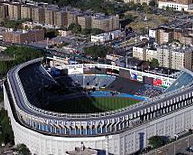
During 1974 and 1975, Yankee Stadium was renovated into its final shape and structure, as shown here in 2002
After the 1974 season, Steinbrenner made a move that started the modern era of free agency, signing star pitcher James Augustus "Catfish" Hunter away from Oakland. Midway through the 1975 season, Steinbrenner made another move, hiring former second baseman Billy Martin as manager. With Martin at the helm, the Yankees reached the 1976 World Series, but were swept by the Cincinnati Reds and their famed "Big Red Machine."
After the 1976 campaign, Steinbrenner added star Oakland outfielder Reggie Jackson to his roster. During spring training of 1977, Jackson alienated his teammates with controversial remarks about the Yankees captain, catcher Thurman Munson. He had bad blood with manager Billy Martin, who had managed the Detroit Tigers when Jackson's Athletics defeated them in the 1972 playoffs. Jackson, Martin, and Steinbrenner repeatedly feuded with each other throughout the life of Jackson's five-year contract. Martin would be hired and fired by Steinbrenner five times over the next 13 years. This conflict, combined with the extremely rowdy Yankees fans of the late 1970s and the bad conditions of the Bronx, led to the Yankee organization and stadium being referred to as the "Bronx Zoo."[23] Despite the turmoil, Jackson starred in the 1977 World Series, when he hit three home runs in the same game, and overall, four home runs on four consecutive pitches from four different pitchers. Jackson's great performance in the postseason earned him the Series MVP Award, and the nickname "Mr. October."[24]
Throughout the late 1970s, the race for the pennant was often a close competition between the Yankees and the Red Sox. In the 1950s and early 1960s, the Yankees had been dominant while the Red Sox were largely a non-factor. However, in the late 1960s and early 1970s, the Yankees were mired in second place and the Red Sox led the league. In the late 1970s the two teams were contending simultaneously and locked in a close fight.
On July 14, 1978, the Yankees were 14 1⁄2 games behind the Red Sox. The Yankees went on a long winning streak, and by the time they met Boston for a pivotal four-game series at Fenway Park in early September, they were only four games behind the Red Sox. The Yankees swept the Red Sox in what became known as the "Boston Massacre", winning the games 15–3, 13–2, 7–0, and 7–4. The third game was a shutout pitched by "Louisiana Lightning" Ron Guidry, who would lead the majors with nine shutouts, a 25–3 record, and a 1.74 ERA. Guidry finished with 248 strikeouts, but Nolan Ryan's 260 strikeouts with the California Angels deprived Guidry of the pitching Triple Crown.
On the last day of the season, the two clubs finished in a tie for first place in the AL East, and a one-game playoff (the 163rd game of the regular season) was held at Fenway Park. With Guidry pitching against former Yankee Mike Torrez, the Red Sox took an early 2–0 lead. In the seventh inning, light-hitting Yankee shortstop Bucky Dent drove a three-run home run over the "Green Monster" (Fenway Park's famed left field wall), putting the Yankees up 3–2. Reggie Jackson's solo home run in the following inning sealed the eventual 5–4 win that gave the Yankees their one hundredth win of the season and their third straight AL East title and Guidry earned his 25th win of the season.
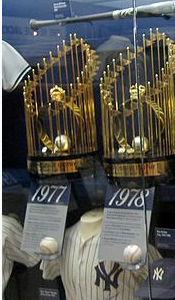
The Yankees' 1977 and 1978 trophies on display at the Yankees Museum in the newYankee Stadium.
After beating the Kansas City Royals for the third consecutive year in the ALCS, the Yankees faced the Dodgers again in the World Series. They lost the first two games in LA, but won all three games at Yankee Stadium and won Game 6 in Los Angeles, winning their 22nd World Championship.
Changes occurred during the 1979 season. Former Cy Young Award-winning closer Sparky Lyle was traded to the Texas Rangers for several players, including Dave Righetti. Tommy John was acquired from the Dodgers and Luis Tiant from the hated Red Sox to bolster the pitching staff. During the season, Bob Lemon was replaced by Billy Martin.
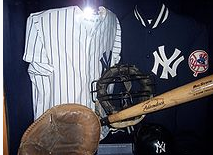
The mask and catcher's mitt ofThurman Munson, the team captain who was killed in a plane crash in 1979
The 1970s ended on a tragic note for the Yankees. On August 2, 1979, Thurman Munson died after crashing his private plane while practicing "Touch and Go" landings. Four days later, the entire team flew out to Canton, Ohio for the funeral, despite having a game later that day against the Orioles. Martin adamantly stated that the funeral was more important, and that he did not care if they made it back in time. Bobby Murcer, a close friend of Munson's, was chosen to give the eulogy at his funeral. In a nationally televised and emotional game, Murcer used Munson's bat (which he gave to his fallen friend's wife after the game), and drove in all five of the team's runs in a dramatic 5–4 walk-off victory. Before the game, Munson's locker sat empty except for his catching gear, a sad reminder for his teammates. His locker, labeled with his number 15, has remained empty in the Yankee clubhouse as a memorial. When the Yankees moved across the street, Munson's locker was torn out and installed in the new Stadium's museum. The number 15 has been retired by the team.
The 1980 season brought more changes to the Yankees. Billy Martin was fired once again and Dick Howser took his place. Chris Chambliss was traded to the Toronto Blue Jays for catcher Rick Cerone. Thanks to Howser's no-nonsense attitude, Reggie Jackson hit .300 for the only time in his career with 41 homers, and finished 2nd in the MVP voting to Kansas City's George Brett. The Yankees won 103 games and the AL East by three games over the 100-win Baltimore Orioles, but were swept by the Royals in the 1980 ALCS.
After the season ended, the Yankees signed Dave Winfield to a ten-year contract. The Yankees fired Howser and replaced him with Gene Michael. Under Michael, the Yankees led the AL East before a strike hit in June 1981. In the second half of the season, the Yankees struggled under Bob Lemon, who replaced Michael. Thanks to the split-season playoff format, the Yankees faced the second-half winner Milwaukee Brewers in the special 1981 American League Division Series. After narrowly defeating Milwaukee in five games, they breezed through Billy Martin and the Oakland Athletics in a three-game ALCS. In the World Series, the Yankees got off to a hot start by winning the first two games against the Los Angeles Dodgers. But the Dodgers fought back and stunned the Yankees by winning the next four games to clinch their first World Series title since 1965.
Struggles: The Mattingly Years (1982–1995)
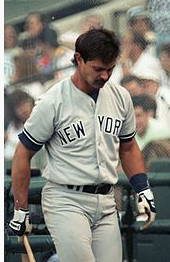
Don Mattingly headlined a Yankees franchise that struggled in the 1980s
Following the team's loss to the Dodgers in the 1981 World Series, the Yankees had their longest absence from the playoffs since 1921. The Yankees of the 1980s were led by All-Star first baseman Don Mattingly. In spite of accumulating the most total wins of any major league team, they failed to win a World Series (the first such team since the 1910s) and had only 1 playoff appearance.[25] They consistently had a powerful offense; Mattingly at various times was teammate to Dave Winfield, Rickey Henderson, Mike Pagliarulo, Steve Sax, and Jesse Barfield, but lacked sufficient starting pitching. After posting a 22–6 record in 1985, arm problems caught up with Ron Guidry, and his performance declined over the next three years.
The team came close to winning the AL East in 1985 and 1986, finishing second to the Toronto Blue Jays and Boston Red Sox (who lost in the World Series that year to the Yankees' cross-town rivals, the New York Mets) respectively, but fell to fourth place in 1987 and fifth in 1988, despite having mid-season leads in the AL East standings both years. Despite their lack of championships and playoff appearances the Yankees posted the highest winning percentage of all MLB teams during the 1980s.
By the end of the decade, the Yankees' offense was on the decline. Henderson and Pagliarulo had departed by the middle of 1989, while back problems hampered both Winfield (who missed the entire '89 season) and Mattingly (who missed almost the entire second half of 1990). Winfield's tenure with the team ended when he was dealt to the Angels. From 1989 to 1992, the team had a losing record, spending significant money on free-agents and draft picks who did not live up to expectations. In 1990, the Yankees had the worst record in the American League, and their first last-place finish since 1966.



















